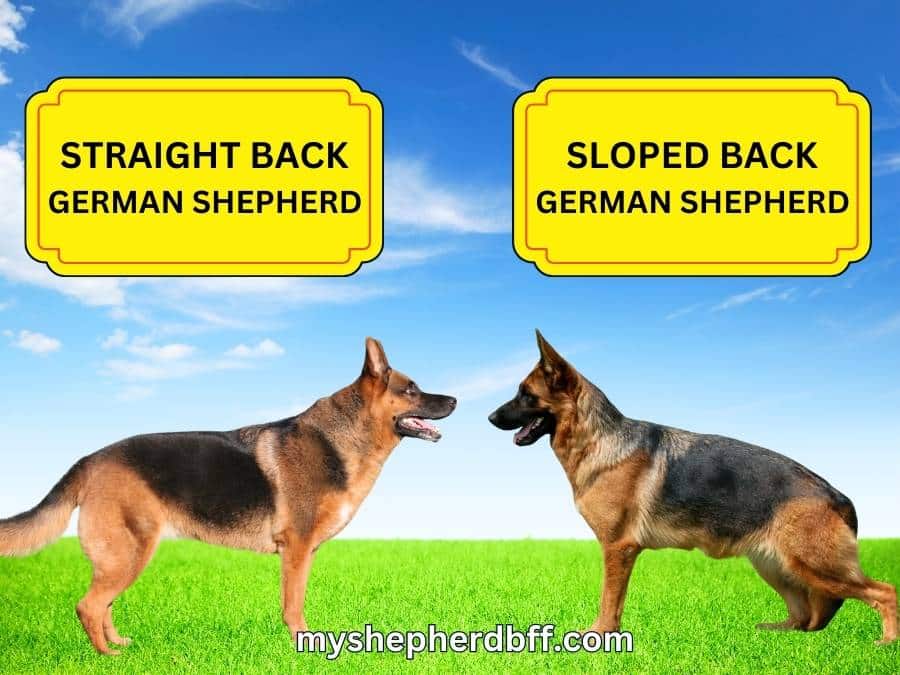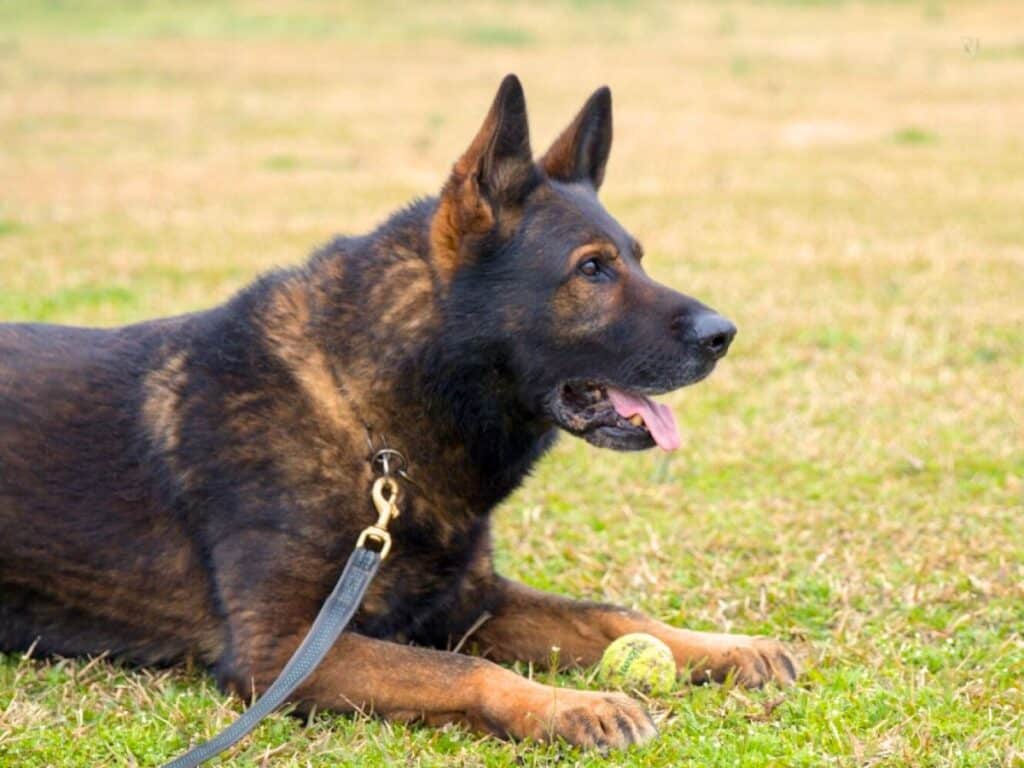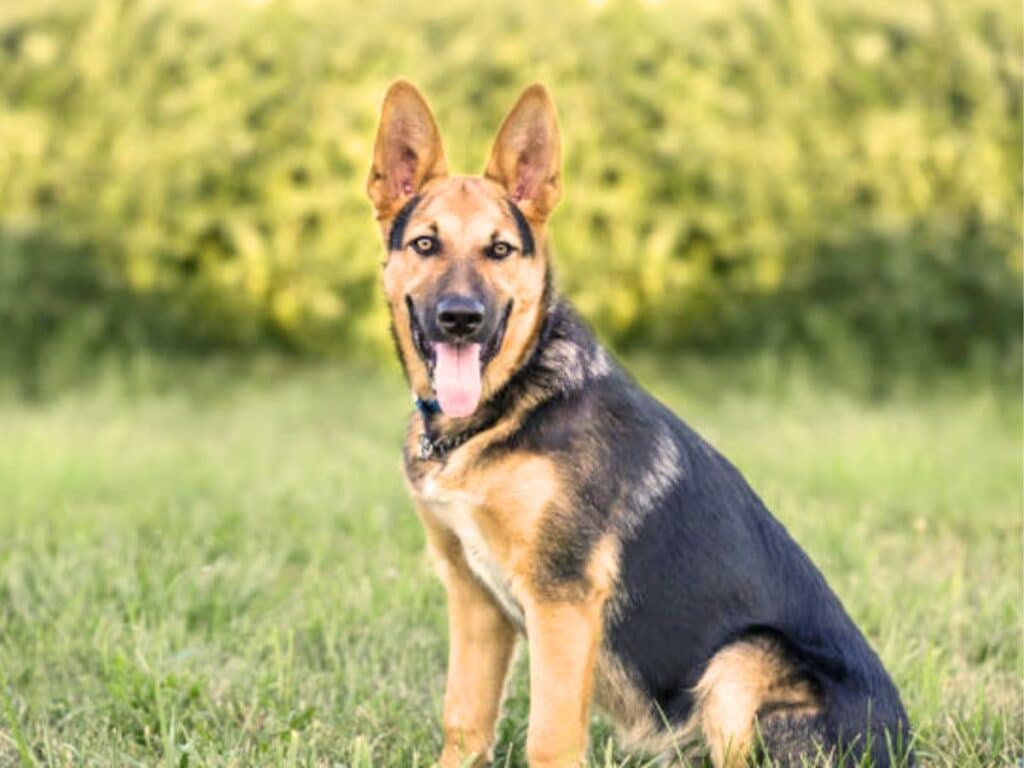Some breeders and enthusiasts may favor sloped-back German Shepherds over straight backs, believing them to be ideal. Yet, this sloping back alters their hindquarters’ structure, making these dogs more susceptible to back problems and disorders.
Historically, the straight back German Shepherd was the norm, favored for their working abilities. However, over time, breed standards shifted towards a sloped back appearance due to show preferences.
The difference between straight back and sloped back German Shepherds is not merely cosmetic but touches on aspects of history, breeding practices, and health implications.
In this article, we will explore their origins, highlighting how and why these distinct backlines developed, and how these differences affect their appearance, movement, and overall health.
Straight Back vs Sloped Back German Shepherd: Overview
Below is a comparison table that outlines the key differences between straight back and sloped back German Shepherds in terms of their physical characteristics, including height, weight, and overall physique.
| Feature | Straight Back GSD | Sloped Back GSD |
|---|---|---|
| Height (Males) | Males: 24 to 26 inches Females: 22 to 24 inches | Males: 24 to 26 inches Females: 22 to 24 inches |
| Weight (Males) | Males: 65 to 90 poundsFemales: 50 to 70 pounds | Males: 65 to 90 poundsFemales: 50 to 70 pounds |
| Bloodlines | Mostly working-line dogs | Mostly show-line dogs |
| Backline | Straight from shoulders to tail | Distinct sloping from shoulders to tail |
| Overall physique | Balanced, robust, and muscular, reflecting a traditional working dog appearance | More elongated, leaner appearance due to pronounced rear angulation |
| Movement | Powerful and efficient gait, strong drive from the hindquarters, balanced | Smooth, flowing gait, appears effortless, longer stride length |
| Suitability | Versatile for various roles including work, service, and companionship | Often preferred for show due to elegant appearance and movement |
| Health considerations | Generally perceived to have fewer health issues related to structure, though individual health can vary | Ongoing debate about potential impact of sloped back on health, particularly hip and spinal issues |
| Family suitability | Excellent | Excellent |
| Temperament | Loyal, protective, high energy, good with kids, intelligent, wary of strangers, highly trainable | Loyal, protective, high energy, good with kids, intelligent, wary of strangers, highly trainable |
| Lifespan | 9–13 years | 9–13 years |

Straight Backs: The Original Old-Style German Shepherds
Straight-backs or Old-style German Shepherds represent the breed’s original dogs. As the breed began to be standardized in 1923, it was Max von Stephanitz, often hailed as the father of the German Shepherd breed, who played a pivotal role in shaping what the German Shepherd would become.
Von Stephanitz’s vision was to breed a dog capable of herding and protecting sheep across Germany.
This vision culminated in the creation of the German Shepherd, a breed characterized by its versatility, intelligence, and notably, a straight and powerful back.
Von Stephanitz’s seminal book on the breed, titled The German Shepherd Dog in Word and Picture, published in 1923, explicitly describes the German Shepherd’s back as being “straight and powerful,” underscoring his belief that a straight back was crucial for the breed’s physical prowess.
He argued that any deviation from this, particularly curving of the spine, would only compromise the dogs’ speed and endurance, effectively limiting their capabilities.
The straight-back German Shepherds of today are direct descendants of these original working dogs, spared from the excessive breeding practices that have introduced the sloped back into the breed.
Origin of Sloped Backs
The majority of sloped-back German Shepherds are not primarily utilized as working dogs. Instead, their breeding has been largely driven by the demands of dog show competitions rather than companionship or work.
This shift in breeding focus has gradually altered the breed’s standard from a more traditional rectangular body shape to a triangular silhouette, characterized by a pronounced sloped back.
Initially, this trend towards a sloped back was not a significant concern, but over decades, it has become a defining characteristic sought after in show rings.
This evolution in the breed standard means that dogs with more pronounced slopes to their backs are often more successful in competitions, influencing breeders to favor this trait.
Sloped vs Straight Backs: Visual Differences
Straight Back GSDs
Straight back German Shepherds are characterized by a level and straight topline from the neck to the tail. This breed maintains a natural posture, with hind legs that align perfectly under their body.

The level back contributes to a natural, upright stance, and the shoulders are well-angled, allowing for smooth movement and agility.
Physically, straight back German Shepherds possess a muscular and robust build, with a deep chest and a body length slightly longer than their height at the withers.
Their well-proportioned structure allows for a powerful and effortless gait, enabling these dogs to cover ground quickly and efficiently.
Their movement is characterized by a strong drive from the hindquarters and a free reach from the front, displaying stamina and agility.
Sloped Back GSDs
The most defining characteristic of the sloped back German Shepherd is the angled topline, which slopes downwards from the withers to the hindquarters.

This angulation is not merely cosmetic; it’s a feature that has been selectively bred for, particularly in lines focused on conformation and show competition.
The slope is intended to contribute to a more extended, flowing gait, allowing the dog to cover ground with fewer steps, which is highly valued in show rings.
Sloped back German Shepherds exhibit a well-muscled build, with a strong and pronounced curvature in their hindquarters.
This breed variation maintains the German Shepherd’s signature muscular physique and deep chest, but with added emphasis on rear angulation.
This unique angulation allows the sloped back German Shepherd to perform well in the show ring, where movement and appearance are closely scrutinized.
While a sloped back is highly prized in show environments, it has sparked discussions regarding its impact on the breed’s overall health and suitability for traditional working roles.
Health Implications of a Sloped Back in GSDs
The structure of the spine in German Shepherds, whether straight back or sloped back, plays a significant role in their overall health.
The debate between the health impacts of the two spine structures is ongoing, with studies and veterinary insights providing valuable information.
Hip Dysplasia
Hip dysplasia is a condition that involves the malformation of the hip joint, leading to arthritis and pain.
The risk of hip dysplasia is influenced by genetic and environmental factors, but the physical structure, including the alignment of the spine and hindquarters, can also play a role.
- Straight Back German Shepherds are often thought to have a lower risk of hip & elbow dysplasia due to their more natural, level backline, which promotes a balanced distribution of weight and reduces undue stress on the hip joints.
- Sloped Back German Shepherds, with their distinct angulation from shoulders to tail, may be perceived to have an increased risk of hip & elbow dysplasia. The argument is that the sloped back alters the natural alignment and gait, potentially putting additional stress on the hips and leading to an increased risk of joint issues.
Spinal Problems
The spine’s health is critical for any dog’s overall well-being, affecting mobility and quality of life. The structure of the spine in relation to the dog’s backline can influence the risk of developing spinal issues.
- Straight Back German Shepherds have a spine that aligns more closely with their natural, ancestral structure. This alignment is believed to support a healthier spine, potentially reducing the risk of spinal issues such as spondylosis or intervertebral disk disease, which can be exacerbated by undue stress or abnormal spinal alignment.
- Sloped Back German Shepherds may face increased scrutiny regarding spinal health due to their pronounced rear angulation and sloped topline. Critics argue that this structure could lead to an uneven distribution of weight and stress on the spine, potentially increasing the risk of spinal problems. However, comprehensive studies specifically linking the sloped back structure to a higher incidence of spinal issues are limited, and more research is needed to draw definitive conclusions.
While discussions continue regarding the health impacts of straight back versus sloped back German Shepherds, owners and breeders need to focus on comprehensive health screening, responsible breeding practices, and proper care throughout a dog’s life.
RELATED: Common German Shepherd Health Issues

Suitability for Different Roles
The distinction between straight back and sloped back German Shepherds, primarily based on their physical characteristics, does influence their suitability for specific tasks.
Here’s a look at the roles each type is best suited for:
Straight Back German Shepherd
1. Working dogs: The straight back German Shepherd, with its sturdy and balanced physique, is exceptionally well-suited for various types of work. This includes roles such as police work, search and rescue, and military dogs.
Their physical endurance and strength enable them to perform demanding tasks, including tracking, apprehension, and detection work.
2. Service dogs: As service dogs, straight back German Shepherds excel in providing assistance to individuals with disabilities.
Their robust health, intelligence, and trainable nature make them excellent for guiding, mobility assistance, and emotional support.
3. Companionship: Despite their capability for work, straight back German Shepherds are also wonderful companions. They are known for their loyalty, affection, and protective nature, making them great family dogs.
Sloped Back German Shepherd
1. Show dogs: Sloped backs are often bred with an emphasis on aesthetics that align with show ring standards. Their elegant appearance, distinctive gait, and conformity to breed standards make them excellent candidates for the show ring.
Their graceful movement and poise are highly valued in competitions, showcasing the breed’s beauty and noble character.
2. Companionship: Like their straight back counterparts, sloped back German Shepherds can be loving and loyal pets. They share the breed’s intelligence and versatility, capable of being trained for good behavior and companionship.
While they may require careful attention to health and exercise to maintain their physique for show purposes, they are equally capable of forming strong bonds with their families.
3. Specialized Roles: Although there’s a perception that sloped back German Shepherds may not be as suited for intensive physical work as straight back German Shepherds, they can still perform in roles that require intelligence, such as scent work, therapy dog roles, and less physically demanding service dog tasks.

Controversy Over Breeding Sloped Backs
The controversy centers around the emphasis on aesthetic traits—specifically, the pronounced sloping backline—and its implications for the dogs’ health and well-being.
Proponents of sloped backs argue that this feature enhances the German Shepherd’s elegant appearance and graceful movement, traits highly valued in the show ring.
Critics of the sloped back breeding practice express concerns over potential health issues associated with the exaggerated angulation.
The primary worry is that the altered structure may predispose these dogs to spinal problems, hip dysplasia, and other joint-related conditions.
The argument is that the departure from the breed’s original straight back, compromises the dog’s health for the sake of appearance.
Response from Breeders and Kennel Clubs
In response to these concerns, some breeders and kennel clubs have begun to emphasize health screenings and responsible breeding practices.
There is a growing movement within the German Shepherd community to balance aesthetic traits with health and functionality, ensuring that dogs are not only beautiful but also healthy and capable of performing the work for which the breed was originally intended.

Slant Backs or Straight: Which is Better?
When deciding between a straight back and sloped back German Shepherd, consider your lifestyle, the dog’s intended role, and your preferences regarding activity levels and aesthetics.
Straight back German Shepherds are often associated with higher energy levels and a strong work ethic, making them ideal for active families or individuals interested in training for specific tasks such as obedience, agility, or service work.
On the other hand, sloped back German Shepherds, often bred with a focus on conformation to show standards, may excel in the show ring and can be a good match for those interested in competitive showing. Regardless of the type, both can be loving and loyal companions.
It’s crucial to prioritize health, temperament, and compatibility with your lifestyle over physical appearance.
FURTHER READING:




